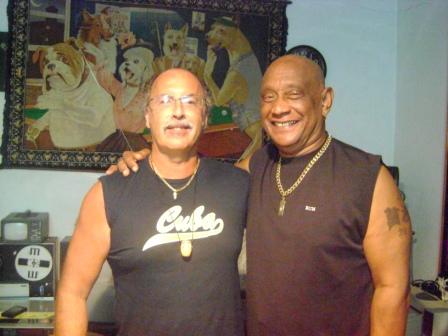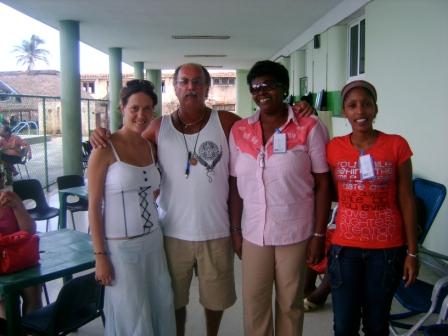Afro-Cuban Culture & US Chicanos
By Patrick Velasquez*

HAVANA TIMES, Oct 10 – While waiting to complete a systematic analysis of transcripts collected during my recent visit to Cuba, I can only rely on short-term memory to describe some of their research directions. One of my premises is that the Afro Cuban culture practiced by many in Cuba provides its youth with a sense of belonging often lacking in U.S. Chicano/Latino youth who are generations removed from their native country and embedded in a U.S. culture that invalidates their own ethnic culture.
Through their Afro Cuban culture, many Cuban youth find a positive place in society through increased knowledge and responsibility (see Jory Farr, The Rites of Rhythm).
My first research interview in Cuba was with Dr. Lino Neira, a music instructor at la Escuela Nacional de Arte (The National Arts School) in Havana. My colleague, Agustin Orozco and I met him and his wife Nessie in the historic, expansive lobby of our hotel (Le Sevilla) in Old Havana. Lino’s doctoral degree focuses on one of several Afro Cuban cultural groups in Cuba, the Abakua. His depth and breadth of knowledge on this subject was indeed impressive.
Lino emphasized that in his opinion, there is no one Cuban culture but rather a diversity of cultures often integrated at the individual level. Thus, at the dimension of religion, a Cuban might incorporate elements of Catholicism along with elements from more than one Afro Cuban religion (e.g., Abakua, Palo, etc.).
According to Lino, even the “whitest” of Cubans might be strong disciples of an Afro Cuban religious sect. He also descried periodic gatherings or “congresses” of Afro Cuban groups that meet to exchange perspectives about their values and beliefs and confirm strategies for the transmission of their religion across generations.
One of my questions for Lino addressed the explicit teaching of Afro Cuban history and cultures throughout Cuban schools. During the conference Agustin and I attended during our first two days in Havana, a Cuban professor named Maya had expressed her satisfaction at seeing how Cuban schools were now, finally, teaching the heritage of Afro Cubans.
However, according to Lino, this was either news to him or it was not as widespread as Maya had inferred. This led to a discussion about a theme that emerged from during the conference as well – the continued prejudice and discrimination against Blacks in Cuba.
As somewhat of a scholar of race and ethnicity (I teach a course each summer at UCSD that addresses racism in society and in higher education), I am convinced that the racial hierarchy in the U.S. is more intractable, harder to deconstruct, and leads to more negative outcomes than any sense of racial hierarchy in Cuba (or other Latin American countries).
Indeed, it would be virtually impossible to compose a U.S. style racial hierarchy in Cuba where the clear majority of the population has at least some African heritage (much as a U.S. style racial hierarchy in Mexico would face a population where the great majority is at least partly of indigenous heritage).
However, much as Fidel Castro himself admitted in his biography, there remains a significant degree of individual prejudice and discrimination against darker-skinned blacks in Cuba and some predominantly “black neighborhoods” in Cuba face extreme levels of material deprivation.

One such neighborhood was the focus of our second interview. During the conference on social justice, we met a Cuban woman named Maria Isabel Romero who works at the Martin Luther King Memorial Center in a barrio called Pogoloti in the municipality of Marianao. Her work involves a number of efforts to establish and maintain the community’s collaborative solutions to its various social problems.
The Martin L. King Memorial Center was established in 1986. However, its community projects intensified in the late 1990’s during the so-called “special period” that gripped Cuba’s economy after the fall of the Soviet Union. Without economic support Cuba’s economy strained mightily to meet its population’s need for basic necessities. This problem was especially serious for barrios like Pogoloti, which Maria Isabel described as one of Havana’s oldest working-class neighborhoods.
It is also a barrio where several different Afro Cuban religions are practiced amongst the people. Unfortunately, Pogoloti was also marked by a high degree of violence, including domestic violence. According to Maria Isabel, that context led to the decision to name this community center after an advocate for peace such as Martin Luther King.
During this period of severe economic strain, which continues to this day, the M.L King Center galvanized Pogoloti’s community leadership to enact collective solutions to its numerous social problems. This shift to community-based analysis of problems and solutions represented somewhat of a change from the traditional model in which the state as a central entity identifies and solves problems.
Maria Isabel described her center’s work as part of a network of such community-based strategies throughout Cuba. At the conference, we also heard from organizers of a similar project in a densely populated barrio in the city of Matanzas.
According to Maria Isabel, there are twenty-eight such projects in various locations throughout Cuba, all of which meet bi-annually in an “encuentro” to share strategies. In addition, these projects are part of a large regional network of community-based efforts throughout Latin America. I felt a strong sense of empathy for their work as Maria Isabel described the challenge in maintaining such a network in which several communities lacked access to email or telephones.
Before I left the center, Maria Isabel emphasized the continuing, severe economic strain faced by Cuba, no small part of which is accounted for by the U.S. blockade. She reiterated that the community-based system of analysis in Cuba was still somewhat under-developed in a society that frequently emphasizes an engagement with international, macro-level issues.

I felt a deep respect for Maria Isabel and her compatriots who struggle to maintain a focus on the collective daily life of working Cubans, (to view a website that contains newsletters for the Martin Luther King Center, see http://www.ecaminos.cu/).
My third interview was with one of Pogoloti’s foremost residents, the Grammy-winning percussionist Oscar Valdes. A product of this working-class barrio in which schooling was virtually non-existent before the Revolution, Valdes gained international fame as a founding member of Cuba’s seminal jazz group, Irakere. In his (thankfully) air conditioned, upstairs studio, surrounded by conventional tumbadoras (known in the U.S. as conga drums), Agustin and I videotaped a thirty-minute interview with this master musician.
I was most interested in how Valdes, as a young man in one of Havana’s poorest barrios, learned to play percussion and the role of Afro Cuban religion in his musical socialization. He told us that at a very young age, he learned to play drums as part of religious ceremonies.
As Valdes described his early experience playing the sacred, hourglass-shaped Batá drums, a set of these three different sized drums hung on the wall of his studio. With this experience in religions drumming passed along to him by relatives, Valdes later began to play the congas in his father’s band.
When Oscar, pianist Jesus “Chucho” Valdes, and bassist Carlos del Puerto founded Irakere in the early 1970’s, Oscar Valdes role included the infusion of not only the sacred Batá drums within the harmonic context of jazz but also the use of drums from Pogoloti’s other religious groups including the Abakua and Arará. These drums can also be seen in Valdes’ studio alongside the Grammy Award and Grammy nomination Irakere received during their heyday.
After we completed the interview, Agustin and I sat with Valdes in his downstairs living room while his wife served us the most delicious coffee (and probably the strongest) I had ever tasted. He told us about his recent trip to Japan, where he both performed and conducted percussion workshops for eager audiences, along with his plans to visit the U.S. in December, 2009. Apparently, the U.S. government’s granting of visas for cultural ambassadors like Valdes was being relaxed somewhat.
As we left his comfortable, immaculate home in a barrio where most residences were in disrepair (as his daughter set up to practice the upright bass), I marveled at how easy it had been to contact and meet one of the greatest percussionists in the history of Afro Cuban music.
The Los Angeles-based percussionist, Chuck Silverman, who travels frequently to Cuba, had graciously provided me Valdes’ phone number. From there, I simply phoned Valdes, introduced myself, and asked if I might visit his home to speak with him. He honored my request as if it were the most natural thing to do. Imagine visiting the U.S. and calling Bruce Springsteen to meet with him. Simple, no? Cuba is indeed a different world.
Supplied with a valuable field date, Agustin and I returned to San Diego with mixed feelings. We agree that we had learned a great deal on this trip to Havana but that seven days was simply not enough time to analyze any facet of such a complex society. At least we had established some directions towards answers to our research questions. Further analysis awaited us. In my next article, I will shift the perspective from research to more intuitive observations and conclusions.
*Philosophy professor at the University of California at San Diego.





